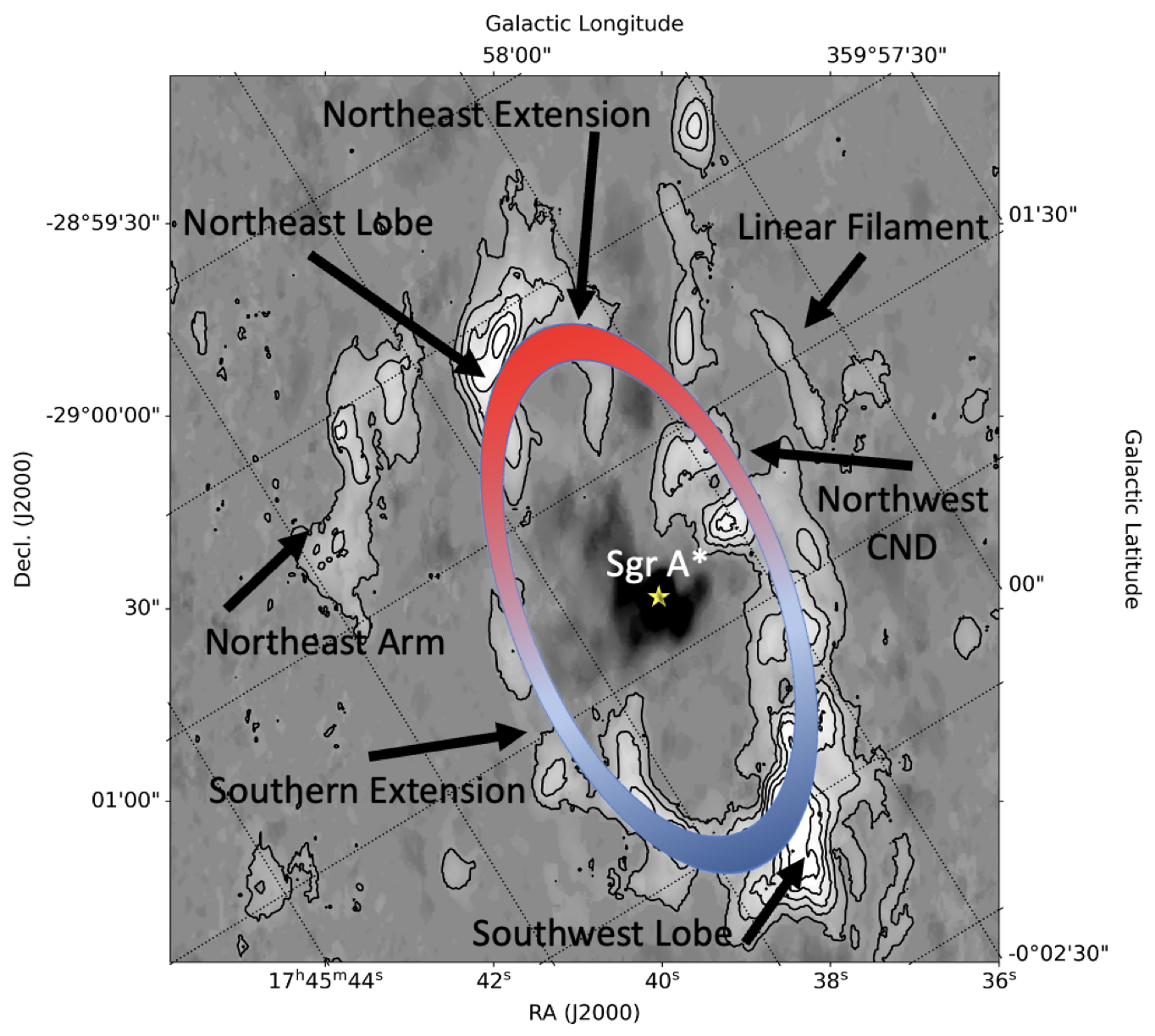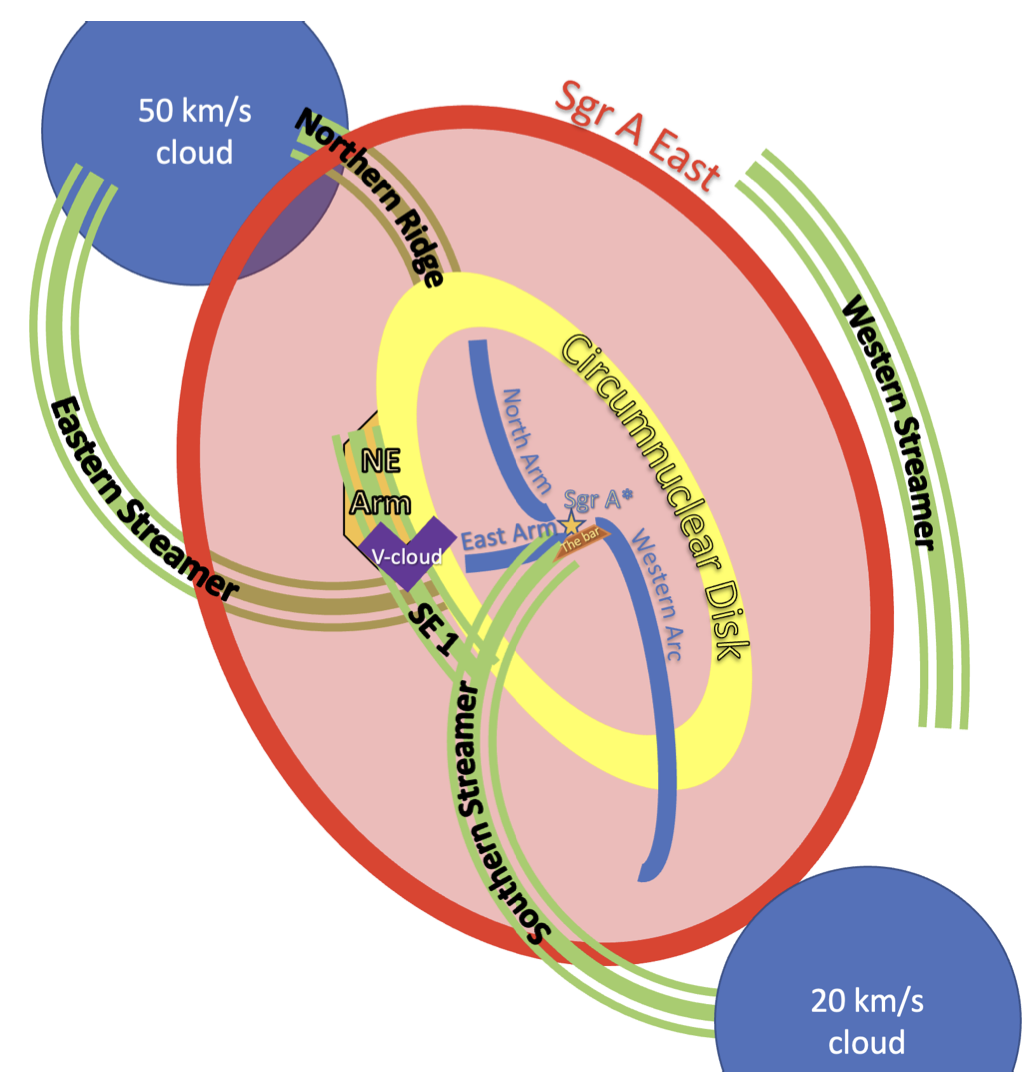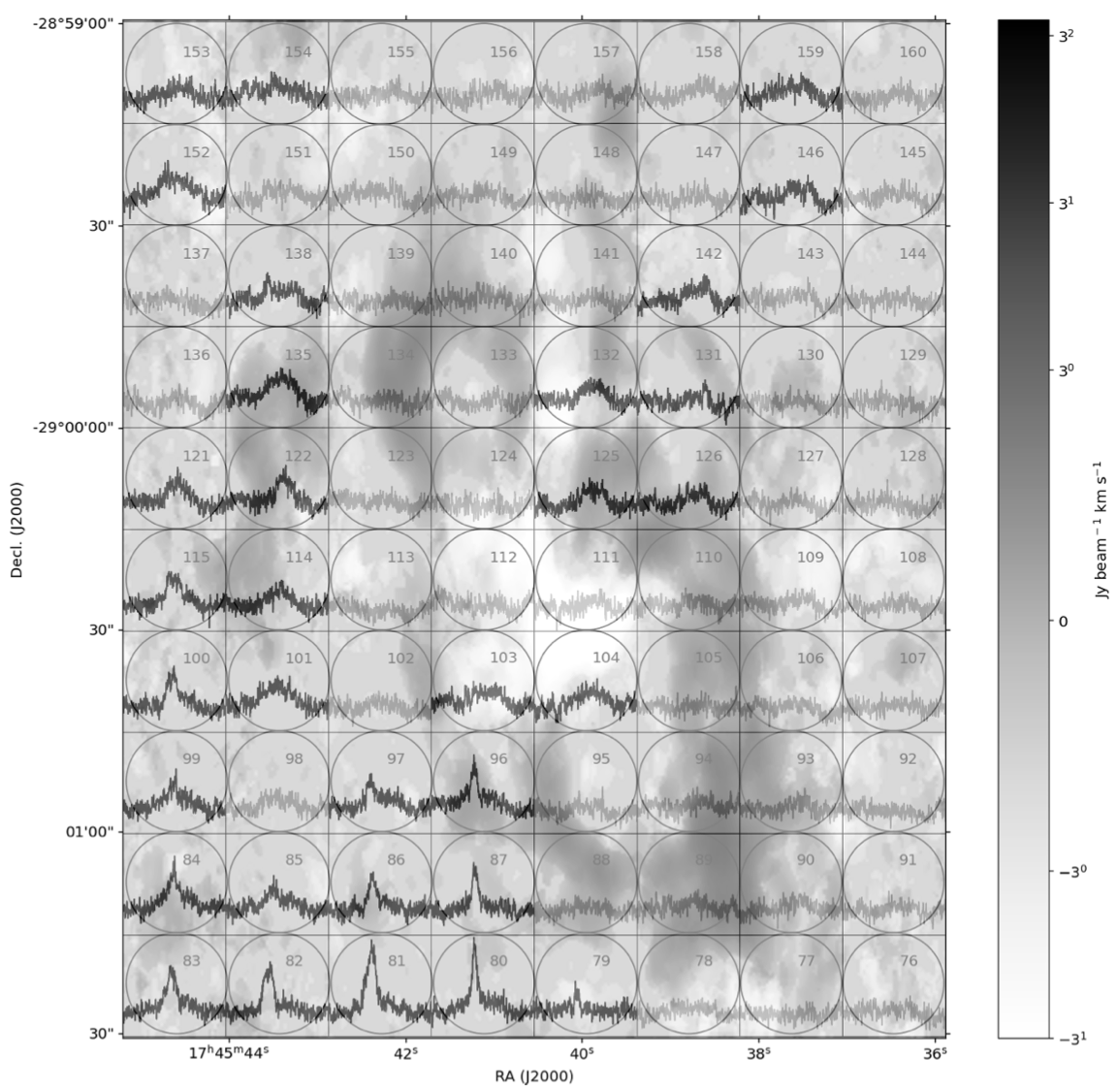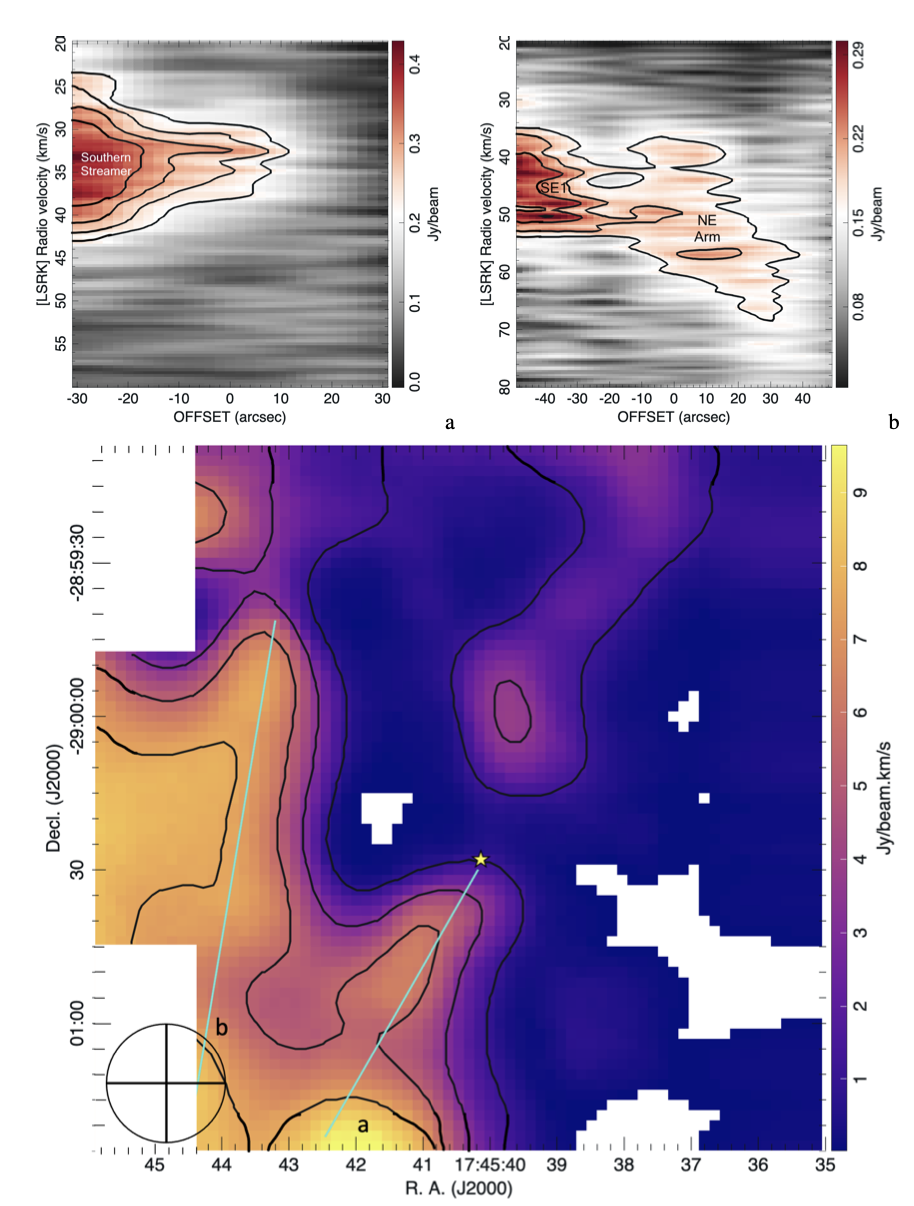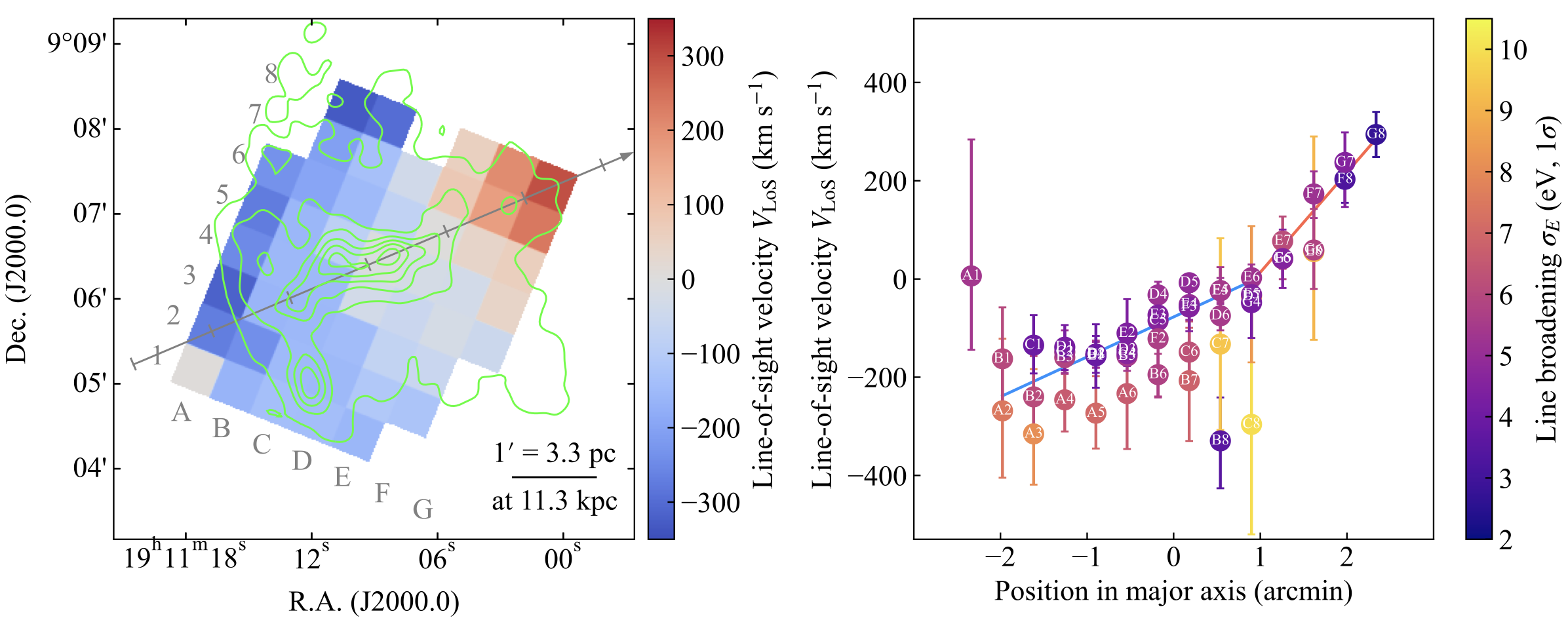

I take notes on ArXiv articles that pique my personal interest, just in case I forget.
This file was originally written in markdown.
SNR-W49B
Sgr B2-water maser
C+N abundance/YSO jets/ACES-GC
Line absorption in diffuse gas/QUIJOTE: HS2
HII [CII]/maser flare - MIR light echo
SiO-GC
SNR-W49BKinematic Evidence for Bipolar Ejecta Flows in the Galactic SNR W 49B (2506.05455)
XRISM Collaboration
Tags:
SNR
X-Ray
W49B, a unique Galactic SNR with centrally peaked, “bar”-like ejecta distribution, which was once considered evidence for a hypernova origin that resulted in a bipolar ejection of the stellar core. However, chemical abundance measurements contradict this interpretation. The morphology and velocity distribution of the ejecta provide critical details for understanding the explosion mechanism.
Using XRISM/Resolve, they measured the line-of-sight velocity
traced by the Fe Heα emission to vary by ±300 km/s with a smooth east-to-west gradient of a few tens of km/s/pc along the major axis.
The discovery of the east-west gradient in the line-of-sight velocity, together with the absence of a twin-peaked line profile or enhanced broadening in the central region, clearly rejects the equatorially expanding disk model. They propose an alternative scenario that would be a collimation of the ejecta by an elongated cavity sculpted by bipolar stellar winds.


Sgr B2-water maserProperties of H2O masers and their associated sources in Sagittarius B2 (2506.09115)
Nazar Budaiev, Adam Ginsburg, Ciriaco Goddi, Álvaro Sánchez-Monge, Anika Schmiedeke, Desmond Jeff, Peter Schilke, Christopher De Pree
Tags:
H2O maser
Sgr B2
Sgr B2, known for its high star-formation rate (∼0.04 M⊙ yr−1, 10% of the star formation in the CMZ; Ginsburg et al. 2018), whose extreme environmental conditions and clustered star formation makes it a compelling analog for star formation at during the peak epoch of cosmic star formation (z ∼ 2; Madau & Dickinson 2014).
High-resolution multi-wavelength observations resolve the immediate environments of individual massive protostars, and feedback, infall, and dynamical interactions within the forming star clusters, thereby providing crucial context for the physical interpretation of maser emission.
They detected 499 H2O masers in observed velocities (-39 to 172 km/s) and identified 144 unique sites of H2O maser emission.
The outflow-associated H2O maser emission is confined to within < 2000 au of the central continuum source, while shocked SiO emission extending over tens of thousands of au.
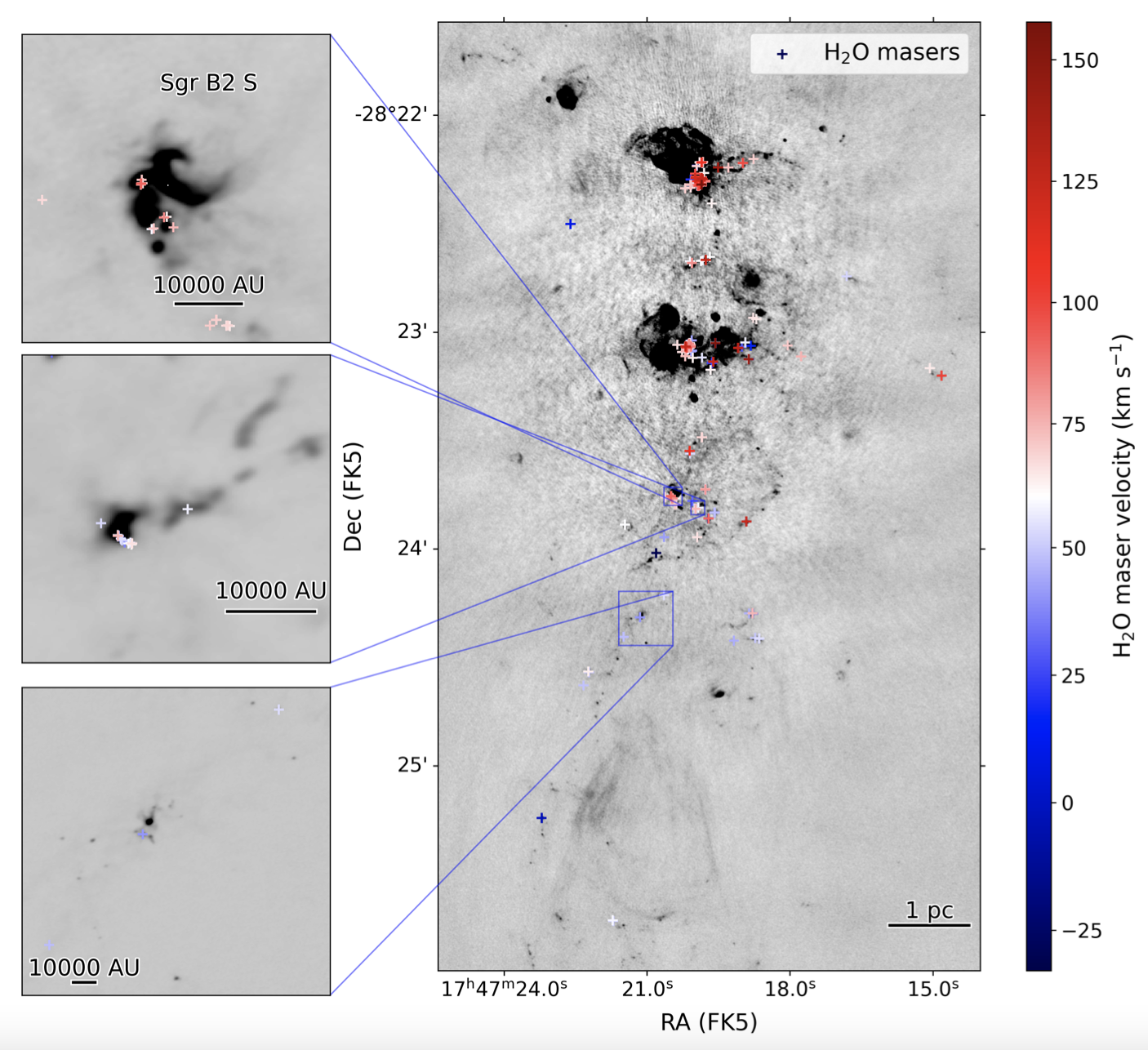
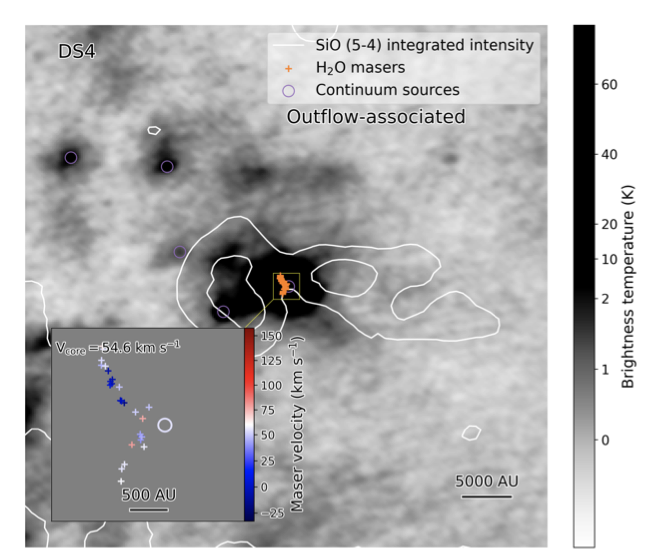
C+N abundance/YSO jets/ACES-GCC and N abundances in globular clusters. I. The case of 47 Tuc and the effect of the first dredge-up.
Implications for the isochrone fitting (2506.11278)
S. Villanova, L. Monaco, Y. Momany, A. Plotnikova, and I. Ordenes
Tags:
C+N abundance
47 Tuc
1st dredge-up
Aims: they investigate chemical variations in the globular cluster NGC104 (47Tucanae), to trace multiple stellar populations across evolutionary phases and examine how the C/N anti-correlation evolves from the main sequence (MS) to the asymptotic giant branch (AGB).
Methods: analysing [C/Fe] and [N/Fe] abundances from spectra for a large stellar sample covering all evolutionary stages.
CN and the CH features → abundance; photometry → atmospheric parameters
The inferred abundances → disentangle multiple populations along the CMD and refine cluster parameters.
Results: they find that MS stars are more C- and N-rich than their RGB, HB, and AGB counterparts. The C/N anti-correlation shifts during the sub-giant branch phase, coinciding with the first dredge-up: C decreases by 0.15-0.20 dex, N by ∼0.1 dex, while Fe remains unchanged.
YSO Jets Driven by Magnetic Pressure Generated through Stellar Magnetosphere–Disk Interaction (2506.11333)
Yisheng Tu, Zhi-Yun Li, Zhaohuan Zhu, Xiao Hu, and Chun-Yen Hsu
Tags:
YSO
Jet
Stellar magnetospheres
Circumstellar disks
They present a 3D non-ideal magnetohydrodynamic simulation of jet launching in YSOs, focusing on the interaction between the stellar magnetosphere and the circumstellar disk.
Magnetosphere Opening:
At simulation start, the magnetosphere partially opens, forming two oppositely directed magnetic field regions: One threading the star; One threading the inner disk
The disk-threading field dominates at small radii and contributes launch a disk wind.
Jet Launching Mechanism: Jet is launched from the interface between these regions by toroidal magnetic pressure generated along “two-legged” field lines, anchored at a magnetically dominated stellar footpoint and a mass-dominated point on the disk surface.
Outflows driven via "Load-Fire-Reload Cycle":
Load: Differential rotation builds up toroidal magnetic fields.
Fire: Vertical toroidal field gradients drive outflows and release energy.
Reload: Magnetic reconnection resets the field configuration.
This cycle is rapid and asynchronous across azimuths, sustaining a continuous, large-scale outflow.
Energy Transport: Poynting flux transports the toroidal field from the vicinity of the star into the polar cavity, powering the jet.

Circum-nuclear eccentric gas flow in the Galactic Center re-
vealed by ALMA CMZ Exploration Survey (ACES) (2506.11553)
Yoshiaki SOFUE, Tomoharu OKA, Steven N. LONGMORE, Daniel WALKER, Adam GINSBURG et al.
Tags:
GC
ACES
A high-velocity compact cloud (HVCC) at (l,b,vLSR) ∼ (+0.02deg , −0.02 deg, 100 km/s) (hereafter G0.02). The longitude-velocity diagram (LVD) of the cloud draws an elliptical structure, which is interpreted as an orbital trajectory in the (l,vLSR) space of a noncircular (eccentric) motion of the molecular gas in the gravitational potential of an extended mass distribution in the central 10 pc of the Galaxy. They argue that G0.02 is a kinematic tracer of the inner potential, a rare case of a dense gas following an eccentric orbit in the nuclear gravitational field.


Line absorption in diffuse gas/QUIJOTE: HS2CO, CS, HCO, HCO+, C2H, and HCN in the diffuse interstellar medium (2506.12518)
H. Liszt and M. Gerin
Tags:
diffuse ISM
HI-H2
Radio frequency molecular absorption lines demonstrate the molecular character of the dark neutral medium (DNM) that is present at the HI-H2 transition in diffuse or translucent interstellar gas (AV < 1 mag).
C2H is ubiquitous, and N(C2H)/N(HCO+) increases at smaller EB−V and smaller N(HCO+), but C2H absorption is intrinsically weaker, which lowers the number of sight lines with a low column density along which it was detected.
The dense-gas tracer HCN was uniformly detected down to N(H2) = 1020 cm-2, with little change in the relative abundance of N(HCN)/N(HCO+) ≈ 1.25.
HCO was detected along only 4 of 46 sight lines that were newly observed at ALMA because its lines are intrinsically weak, but HCO is ubiquitous in the interstellar medium with N(HCO)/N(HCO+) = 1/3 or N(HCO)/N(H2) = 10-9.
First detection of HS2 in a cold dark cloud (2506.12974)
G. Esplugues, M. Agúndez, G. Molpeceres, B. Tercero, C. Cabezas, N. Marcelino, R. Fuentetaja, J. Cernicharo
Tags:
QUIJOTE: HS2
sulphur
TMC-1
Although sulphur is one of the most abundant species in the Universe, S-bearing molecules are not as abundant as expected in the ISM. The sum of all the observed gas-phase sulphur abundances constitute only <1% of the expected amount (e.g. Fuente et al. 2019). The unknown whereabouts of the remaining S in dense clouds remains an open question.
Models and laboratory experiments suggest that sulphur could be locked into pure S-allotropes (Sx) or into hydrogen sulphides (HSy) (Jiménez-Escobar & Muñoz Caro 2011; Shingledecker et al. 2020). Unlike their oxygenated counterparts, H2S2 still remains undetected in space, and HS2 has only been detected in the Horsehead photon-dominated region (Fuente et al. 2017,2025).
This work report the first detection of HS2 in the cold dark cloud TMC-1. The detection is confirmed by the observation of the fine and hyperfine components of two rotational transitions.
Assumptions of LTE + Trot = 7 K → N(HS2) of 5.7×1011 cm-2. The abundance of HS2 relative to H2 is 5.7×10-11, is about seven times more abundant than its oxygenated counterpart HSO.
Dissociative recombination reactions from the ions H2S2+ and H3S2+ play a major role in forming HS2 (using Nautilus chemical code).
HII [CII]/maser flare - MIR light echoExpansion Signatures in 35 HII Regions traced by SOFIA [CII] Emission (2506.16700)
T. Faerber, L.D. Anderson, M. Luisi, L. Bonne, N. Schneider, V. Ossenkopf-Okada, A. G. G. M. Tielens, R. Simon, and M. Rollig
Tags:
H II regions
C II
The [C II] emission primarily traces PDRs at the transition between ionized and neutral gas.
Although PDRs lack significant ionized hydrogen, they do have ionized gas from atoms with ionization potentials ≤ 13.6 eV. The most common ion in PDRs is therefore ionized carbon ([CII]), as C has an ionization potential of 11.3 eV and is the fourth most abundant element.
As the distance from the ionizing source increases, photons with energies ≥ 11.3 eV are absorbed, resulting in a relatively thin ionized carbon shell. However, it is not the distance itself, but rather the column density of absorbing material that primarily determines the extent of absorption (Tielens & Hollenbach 1985; Hollenbach & Tielens 1999; Wolfire et al. 2022).
Of the 35 H II regions, 12 exhibit clear expansion in PV diagrams, making them expansion candidates, with an average expansion velocity of ∼12.2 km/s. Blueshifted expansion is more common. A comparison of our observations to spherical expansion models supports expansion in eight of 12 ECs. Estimated dynamical ages are 10 to 100 times shorter than the ionizing star lifetimes. Thermal pressure of the ionized gas likely drives expansion in M43, while stellar winds (pressure of the hot plasma created by the stellar wind from the ionizing source) dominate in M17, M42, RCW 120, and RCW 79.
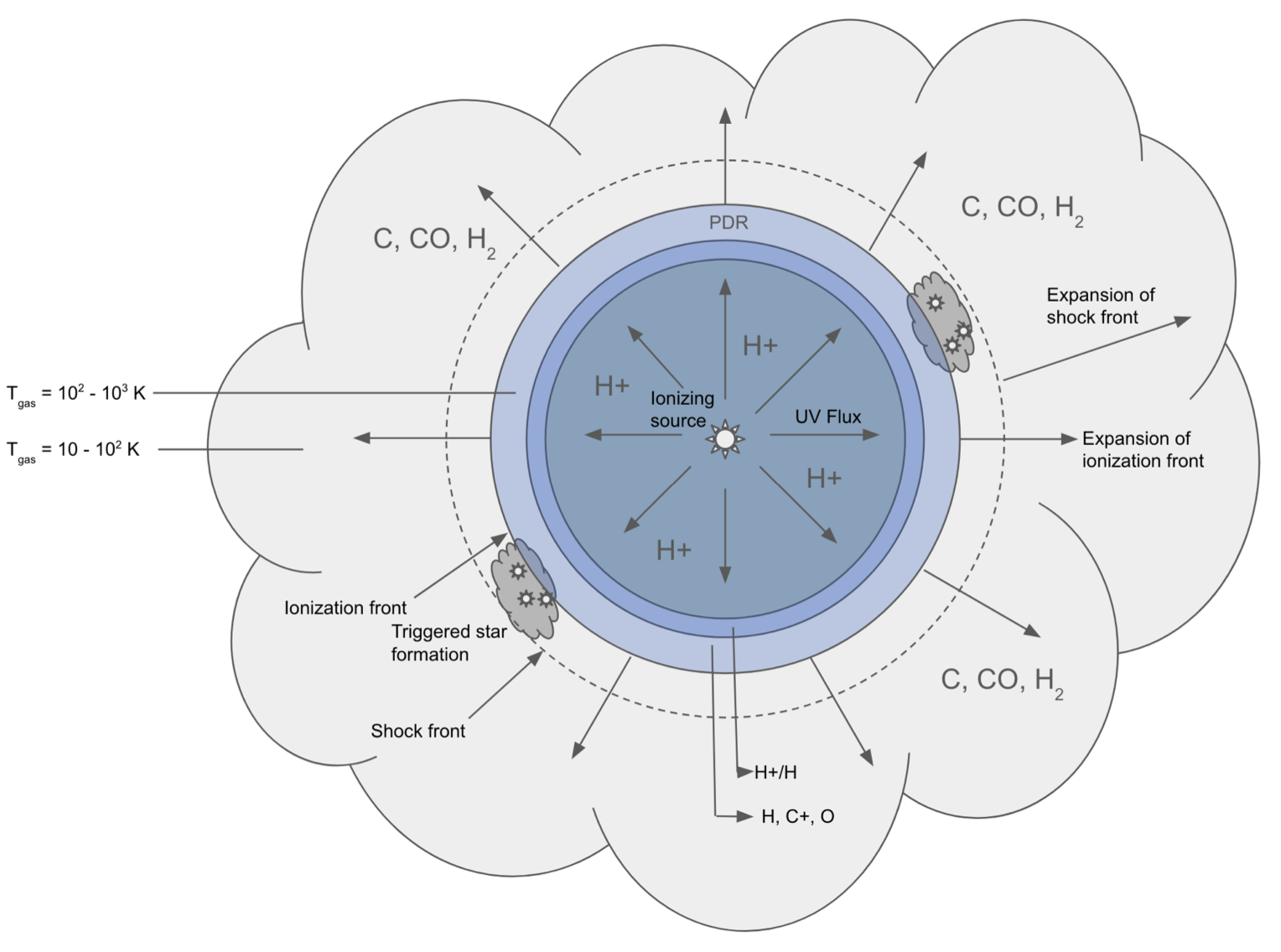
Insights gained from the Light Echo of Cepheus A HW2 (2506.16519)
Bringfried Stecklum, Verena Wolf
Tags:
class II methanol maser flare
MYSO
light echo
Cepheus A HW2 is a well-studied massive young stellar object (MYSO) featuring Class II methanol masers with certain maser components have been found to flare every five years. Difference imaging revealed a light echo (LE), representing a variability record, showing similar periodicity of the masers. Phase and period maps provide information on the circumstellar dust distribution and viewing geometry. This is the first time an LE has been used for reverberation mapping of a YSO environment and expanding its light curve into the past.
SiO-GCParsec-scale SiO emission in the Galactic Center (2507.06347)
N. WENNER, C. J. CHANDLER, J. M. MICHAIL, M. GORSKI, AND J. BRAATZ
Tags:
SiO
GC
circumnuclear disk
Single dish SiO (1–0) observations of the central 5 pc surrounding Sgr A∗ taken with the Green Bank Telescope. Most of the SiO (1–0) traces the southern streamer and Sgr A East–neither of which are associated with the CND. However, one region in the CND, known as the NE Arm, shows high-intensity SiO emission unlike in the rest of the CND, indicating the NE Arm as a candidate region of either cloud-cloud collision or early star formation.
